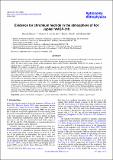Files in this item
Evidence for chromium hydride in the atmosphere of hot Jupiter WASP-31b
Item metadata
| dc.contributor.author | Braam, Marrick | |
| dc.contributor.author | van der Tak, Floris F. S. | |
| dc.contributor.author | Chubb, Katy L. | |
| dc.contributor.author | Min, Michiel | |
| dc.date.accessioned | 2021-12-06T17:30:03Z | |
| dc.date.available | 2021-12-06T17:30:03Z | |
| dc.date.issued | 2021-02-03 | |
| dc.identifier | 276908379 | |
| dc.identifier | db9db536-2142-4b17-9e00-720dc628cb1e | |
| dc.identifier | 000616970000001 | |
| dc.identifier | 85100540259 | |
| dc.identifier.citation | Braam , M , van der Tak , F F S , Chubb , K L & Min , M 2021 , ' Evidence for chromium hydride in the atmosphere of hot Jupiter WASP-31b ' , Astronomy & Astrophysics , vol. 646 , 17 . https://doi.org/10.1051/0004-6361/202039509 | en |
| dc.identifier.issn | 0004-6361 | |
| dc.identifier.other | ORCID: /0000-0002-4552-4559/work/104252881 | |
| dc.identifier.uri | https://hdl.handle.net/10023/24481 | |
| dc.description.abstract | Context. The characterisation of exoplanet atmospheres has shown a wide diversity of compositions. Hot Jupiters have the appropriate temperatures to host metallic compounds, which should be detectable through transmission spectroscopy. Aims. We aim to detect exotic species in the transmission spectra of hot Jupiters, specifically WASP-31b, by testing a variety of chemical species to explain the spectrum. Methods. We conduct a re-analysis of publicly available transmission data of WASP-31b using the Bayesian retrieval framework TAUREX II. We retrieve various combinations of the opacities of 25 atomic and molecular species to determine the minimum set that is needed to fit the observed spectrum. Results. We report evidence for the spectroscopic signatures of chromium hydride (CrH), H2O, and K in WASP-31b. Compared to a flat model without any signatures, a CrH-only model is preferred with a statistical significance of similar to 3.9σ. A model consisting of both CrH and H2O is found with similar to 2.6 and similar to 3σ confidence over a CrH-only model and an H2O-only model, respectively. Furthermore, weak evidence for the addition of K is found at similar to 2.2σ over the H2O+CrH model, although the fidelity of the data point associated with this signature was questioned in earlier studies. Finally, the inclusion of collision-induced absorption and a Rayleigh scattering slope (indicating the presence of aerosols) is found with similar to 3.5σ confidence over the flat model. This analysis presents the first evidence for signatures of CrH in a hot Jupiter atmosphere. At a retrieved temperature of >1481-355 +264 K, the atmosphere of WASP-31b is hot enough to host gaseous Cr-bearing species, and the retrieved abundances agree well with predictions from thermal equilibrium chemistry. Furthermore, the retrieved abundance of CrH agrees with the abundance in an L-type brown dwarf atmosphere. However, additional retrievals using VLT FORS2 data lead to a non-detection of CrH. Future observations with James Webb Space Telescope have the potential to confirm the detection and/or discover other CrH features. | |
| dc.format.extent | 12 | |
| dc.format.extent | 1155233 | |
| dc.language.iso | eng | |
| dc.relation.ispartof | Astronomy & Astrophysics | en |
| dc.subject | Planets and satellites: atmospheres | en |
| dc.subject | Planets and satellites: individual: WASP-31b | en |
| dc.subject | Techniques: spectroscopic | en |
| dc.subject | QB Astronomy | en |
| dc.subject | QC Physics | en |
| dc.subject | 3rd-DAS | en |
| dc.subject.lcc | QB | en |
| dc.subject.lcc | QC | en |
| dc.title | Evidence for chromium hydride in the atmosphere of hot Jupiter WASP-31b | en |
| dc.type | Journal article | en |
| dc.contributor.institution | University of St Andrews. School of Physics and Astronomy | en |
| dc.identifier.doi | 10.1051/0004-6361/202039509 | |
| dc.description.status | Peer reviewed | en |
| dc.identifier.url | https://arxiv.org/abs/2011.10558 | en |
This item appears in the following Collection(s)
Items in the St Andrews Research Repository are protected by copyright, with all rights reserved, unless otherwise indicated.

